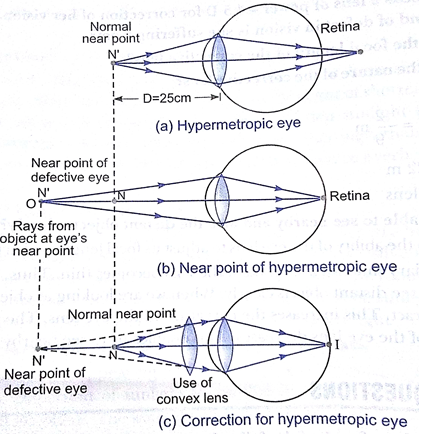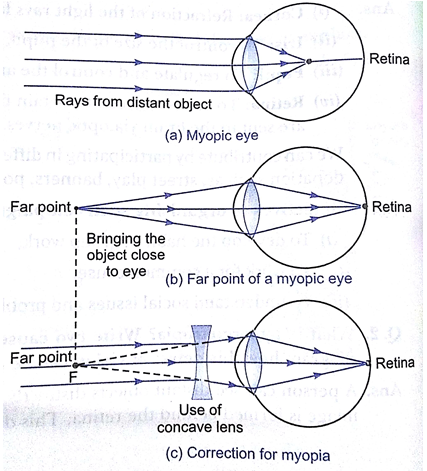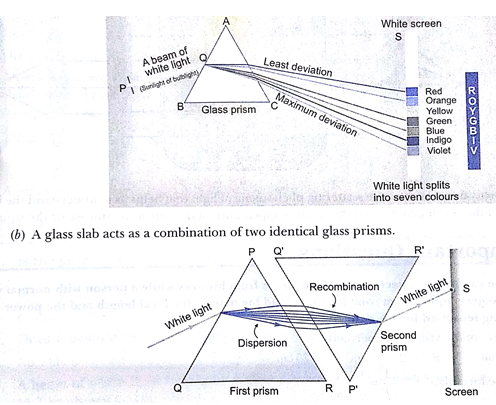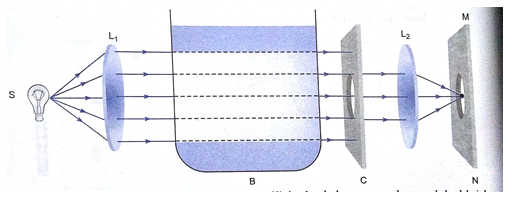Long Answer Questions - 5 Marks
Que 1. State the function of each of the following parts of the human eye:
(i) Cornea (ii) Iris
(iii) Pupil (iv) Retina
Millions of people of the developing countries are suffering from corneal blindness. This disease can be cured by replacing the defective cornea with the cornea of a donated eye. Your school has organised a campaign in the school and its neighbourhood in order to create awareness about this fact and motivate people to donate their eyes after death. How can you along with your classmates contribute in this noble cause? State the objectives of organising such campaigns in schools.
Ans. (i) Cornea: Refraction of the light rays falling on the eye.
(ii) Iris: To control the size of the pupil.
(iii) Pupil: To regulate and control the amount of light entering the eye.
(iv) Retina: To act as a screen to obtain the image of object and generate electrical signals which are sent to the brain via optic nerves.
We can contribute by participating in different ways of motivating people for the noble cause of eye donation such as, street play, banners, poster, door to door campaign, etc.
Objectives of organising such campaigns:
(i) To develop the habit of group work,
(ii) To work for a common cause,
(iii) To understand social issues and problems.
Que 2. What is hypermetropia? Write two causes for development of this defect. Describe with a ray diagram how this defect of vision can be corrected by using spectacles.
Ans. A person can see distant objects distinctly but cannot see nearby objects so clearly in this case, the image is formed behind the retina. This defect of the eye is hypermetropia.

Causes of hypermetropia: This defect arises because either
(i) the focal length of the eye lens is too long, or
(ii) the eyeball becomes too short, so that light rays from the nearby object, say at point N, cannot be brought to focus on the retina to give a distinct image.
Hypermetropia can be corrected by using convex lens of suitable focal length in spectacles.
Que 3. (a) What is myopia? State the two causes of myopia. With the help of labelled ray diagrams show
(i) the eye defect myopia
(ii) correction of myopia using a lens.
(b) Why is the normal eye unable to focus on an object placed within 10 cm from the eye?
Ans. (a) Myopia is the defect of the eye vision due to which a person can see the near by objects clearly but cannot see the far objects so distinctly.
Causes of myopia: Myopia is caused:
−due to the elongation of the eyeball.
−due to decrease in the focal length of the eye lens.

Myopia can be corrected by using a concave lens of suitable focal length in the spectacles of such a person.
(b) The ability of the eye lens to adjust its focal length is called automatic accommodation. However, the focal length of the eye lens cannot be decreased below a certain limit. The maximum accommodation of a normal the object is at a distance of 25 cm from the eyes. Thus, the normal eye is unable to focus an object placed within 10 cm from the eve because all the power of accommodation has already taken place.
Que 4. (a) What is dispersion of white light? What is the cause of dispersion? Draw a diagram to show the dispersion of white light by a glass prism.
(b) A glass prism is able to produce a spectrum when white light passes through it but a glass slab does not produce any spectrum. Explain why it is so.
Ans. (a) The splitting up of white light into its constituent colours on passing through a refracting medium like a glass prism is called dispersion of light.
The dispersion of white light occurs because different colours of light bend through different angles with respect to the incident ray, as they pass through a prism. The red light bends the least while the violet the most as shown below.

The second prism can be considered to be placed in an inverted position with respect to the first. The first prism splits the white light into its seven colour components. When these colour components fall on the second prism, it recombines them to form white light.
Que 5. With the help of an activity show the blue colour of the sky and the reddish appearance of the sun at the sunrise or sunset.
Ans. Activity:
(i) Place a source of light S such as an electric bulb at the focus of a converging lens L1. This lens provides a parallel beam of light.
(ii) Allow the light beam to pass through a transparent glass beaker B of capacity 500 mL.
(iii) After passing through the beaker containing about 400 mL of water allow the light beam to pass through a circular hole made in cardboard C. Obtain a sharp image of the hole on a screen MN using another convex lens L2.
(iv) Dissolve about 200 g of sodium thiosulphate (hypo) in water taken in the beaker B. ADD about 1 to 2 ml of concentrated sulphuric acid with the help of an injection syringe dropwise in the beaker containing hypo solution.
(v) What do you observe?
You will notice fine microscopic sulphur particles precipitating in about seconds. As the sulphur particles begin to form, you can observe the blue light from the sides of the beaker. This is due to scattering of short wavelengths by minute colloidal sulphur particles Observe the colour of the light patch on the screen. It is interesting to observe the change in colour of the patch-from orange red colour in the beginning to bright crimson red colour later on the screen.

This activity demonstrates the scattering phenomena of light that helps us to understand the bluish colour of the sky in general and the reddish appearance of the sun at the sunrise or the sunset.

